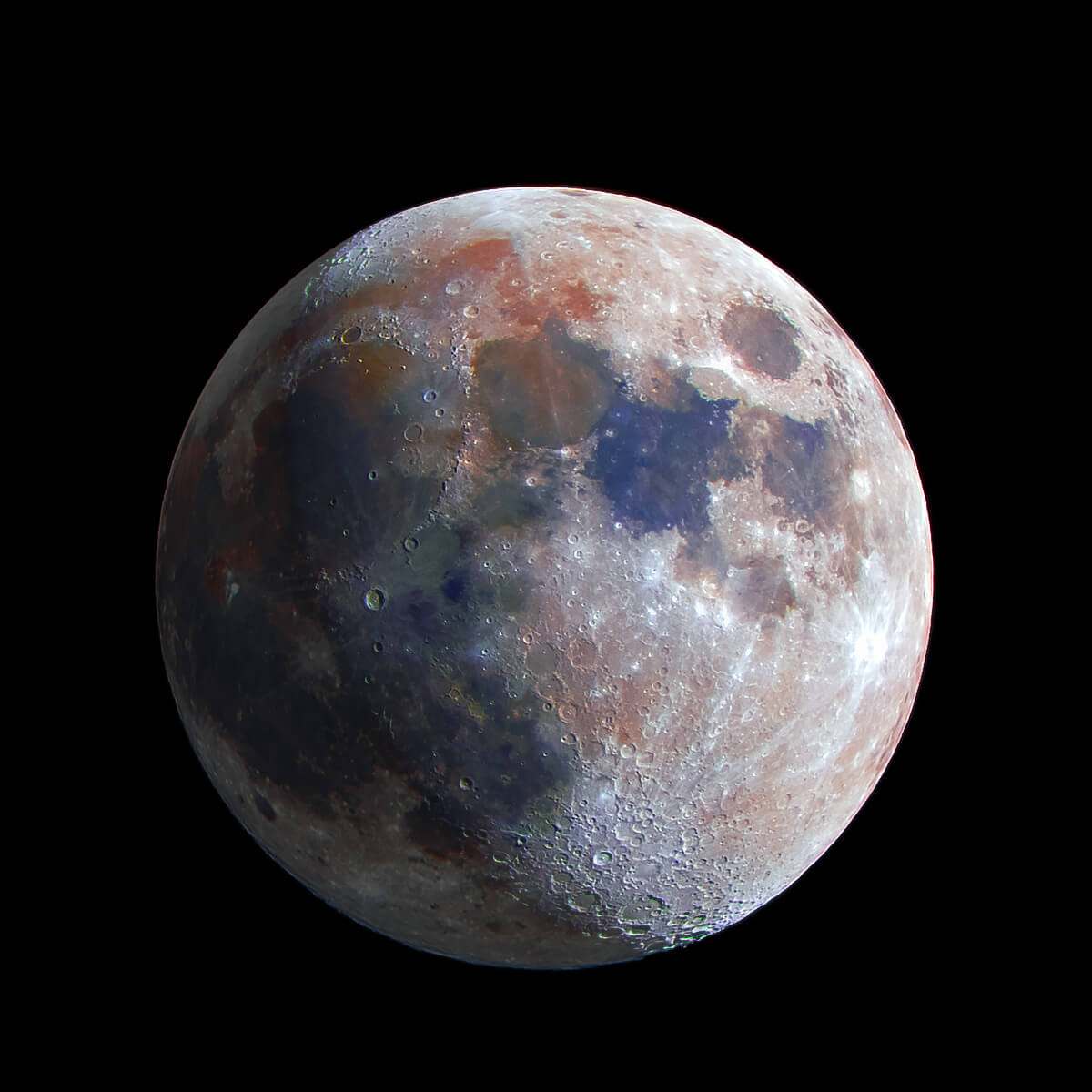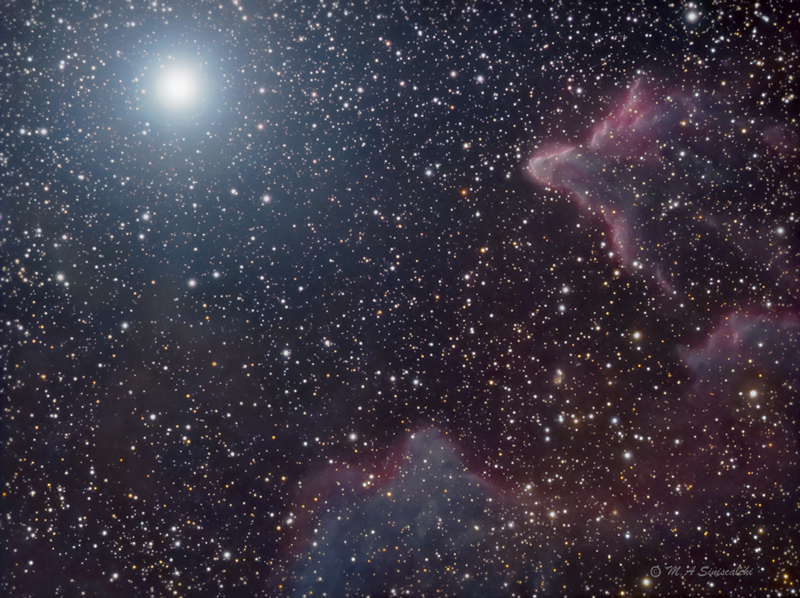Submissions: 2022 January
Re: Submissions: 2022 January
The Pleiades
Copyright: Bogdan Borz
Telescope: William Optics GT 71mm refractor 0.8x reducer
Camera ASI 2600MM, new EFW and OAG @ - 10°C
Baader LRGB 36mm filters
Mount AZEQ6 pro
Exposure : 9h 49 m
Location: Font Romeu, Pyrénées Mountains, France
L 54x180s, 11x300s
R 30x180s, 1x300s
G 29x180s, 10x300s
B 30x180s, 10x300s
SGP, Pixinsight, Photoshop
Full resolution: https://www.astrobin.com/full/c6kjiy/0/
Copyright: Bogdan Borz
Telescope: William Optics GT 71mm refractor 0.8x reducer
Camera ASI 2600MM, new EFW and OAG @ - 10°C
Baader LRGB 36mm filters
Mount AZEQ6 pro
Exposure : 9h 49 m
Location: Font Romeu, Pyrénées Mountains, France
L 54x180s, 11x300s
R 30x180s, 1x300s
G 29x180s, 10x300s
B 30x180s, 10x300s
SGP, Pixinsight, Photoshop
Full resolution: https://www.astrobin.com/full/c6kjiy/0/
Re: Submissions: 2022 January
Filaments of Vela
Copyright: Bogdan Borz/Martin Pugh
Data acquistion and calibration: Martin Pugh
Post-treatment: Bogdan Borz
Ha 19 x 1800s
SII 21 x 1800s
OIII 11 x 1800s
R 4 x 600s
G 3 x 600s
B 3x600s
Total exposure : 27h 40m
Location: Heaven's Mirror Observatory, New South Wales, Australia
Telescope: Astro-physics Riccardi Honders 305mm
Camera: SBIG STXL 16200
Filters: Astrodon 5nm Ha, SII, OIII, RGB
Software: Pixinsight, Photoshop
Full resolution: https://www.astrobin.com/full/apun4g/0/
Copyright: Bogdan Borz/Martin Pugh
Data acquistion and calibration: Martin Pugh
Post-treatment: Bogdan Borz
Ha 19 x 1800s
SII 21 x 1800s
OIII 11 x 1800s
R 4 x 600s
G 3 x 600s
B 3x600s
Total exposure : 27h 40m
Location: Heaven's Mirror Observatory, New South Wales, Australia
Telescope: Astro-physics Riccardi Honders 305mm
Camera: SBIG STXL 16200
Filters: Astrodon 5nm Ha, SII, OIII, RGB
Software: Pixinsight, Photoshop
Full resolution: https://www.astrobin.com/full/apun4g/0/
Re: Submissions: 2022 January
The Mineral Moon
URL: https://tripswithrosie.com
Copyright: Rositsa Dimitrova
Social: https://www.instagram.com/rosie.kerrigan/ December and January are perfect to photograph the true colours of the Moon - the so called Mineral Moon. Our beautiful satellite stands highest in the sky during these months. If you take a few dozen photos (or a video) and stack them together, you'll be able to see colours of the minerals - silica, iron, titanium and others. As the Moon reflects the very bright sunlight, we can't really see those with a naked eye.
URL: https://tripswithrosie.com
Copyright: Rositsa Dimitrova
Social: https://www.instagram.com/rosie.kerrigan/ December and January are perfect to photograph the true colours of the Moon - the so called Mineral Moon. Our beautiful satellite stands highest in the sky during these months. If you take a few dozen photos (or a video) and stack them together, you'll be able to see colours of the minerals - silica, iron, titanium and others. As the Moon reflects the very bright sunlight, we can't really see those with a naked eye.
-
Mike Siniscalchi
- Ensign
- Posts: 22
- Joined: Mon Nov 01, 2010 2:27 am
- Location: Long Island, NY
- Contact:
Submissions: 2022 January
IC63 & IC59 with Gamma Cassiopeiae
Captured using Astrodon RGB+HA filters, SBIG ST2000XM, TMB130 OTA, Losmandy G11.
Exposure times: (Ha) 18 x 10m (R) 6 x 10m (G) 6 x 10m (B) 10 x 10m, Bin 1x1
Software: Images Plus, Photoshop
More image details and a larger version can be found http://helixgate.net/ic63.html Copyright: Michael Siniscalchi
Captured using Astrodon RGB+HA filters, SBIG ST2000XM, TMB130 OTA, Losmandy G11.
Exposure times: (Ha) 18 x 10m (R) 6 x 10m (G) 6 x 10m (B) 10 x 10m, Bin 1x1
Software: Images Plus, Photoshop
More image details and a larger version can be found http://helixgate.net/ic63.html Copyright: Michael Siniscalchi
Re: Submissions: 2022 January
Ngc 1579, the Northern Trifid Nebula in Perseus.
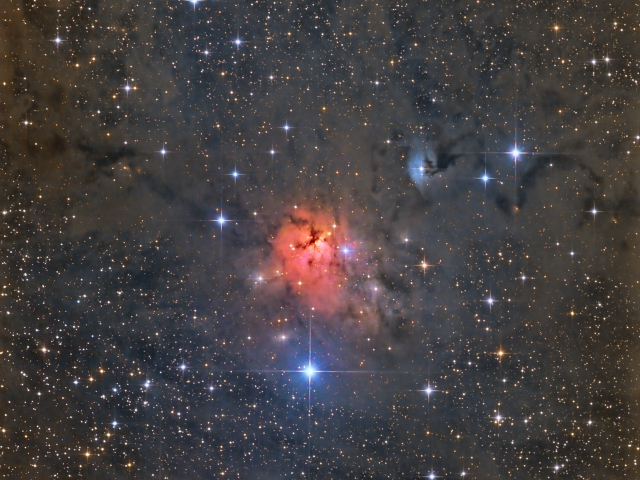
High-resolution image and technical data: http://www.javierlaina.es/IMAGENES/ngc1579.html
Javier Gómez Laina (Spain)
http://www.javierlaina.es/indexeng.html

High-resolution image and technical data: http://www.javierlaina.es/IMAGENES/ngc1579.html
Javier Gómez Laina (Spain)
http://www.javierlaina.es/indexeng.html
Re: Submissions: 2022 January
Hi! This would be my first post here!
On January 15th, 2022, I was talking to a friend in Cozumel who works at the Planetarium. She mentioned that the ISS was going to be near Jupiter that night, and I quickly grabbed my phone and used Ed Morana's ISS Transit Prediction app (You can find it here:
https://play.google.com/store/apps/deta ... l=en&gl=US
And noticed that I was so lucky!! Soooo lucky that the transit was happening in 4 hours, just 10 minutes from my home driving, in a very accessible road!! The weather was not too promising, however. One of the weather apps said 40% cloudy at the time of the transit, others said less than 10%. But I got everything ready: laptop, ZWO camera, telescope, mount, etc and drove there, arriving at around 6:30PM. The transit would happen at exactly 7:08:15 PM (GMT-5), and would last only a fraction of a second! But I was ready! I had read a previous APOD (https://apod.nasa.gov/apod/ap200923.html) had used 0.35ms timing for every frame, and so I used those same settings!!
Here was the location of the transit:
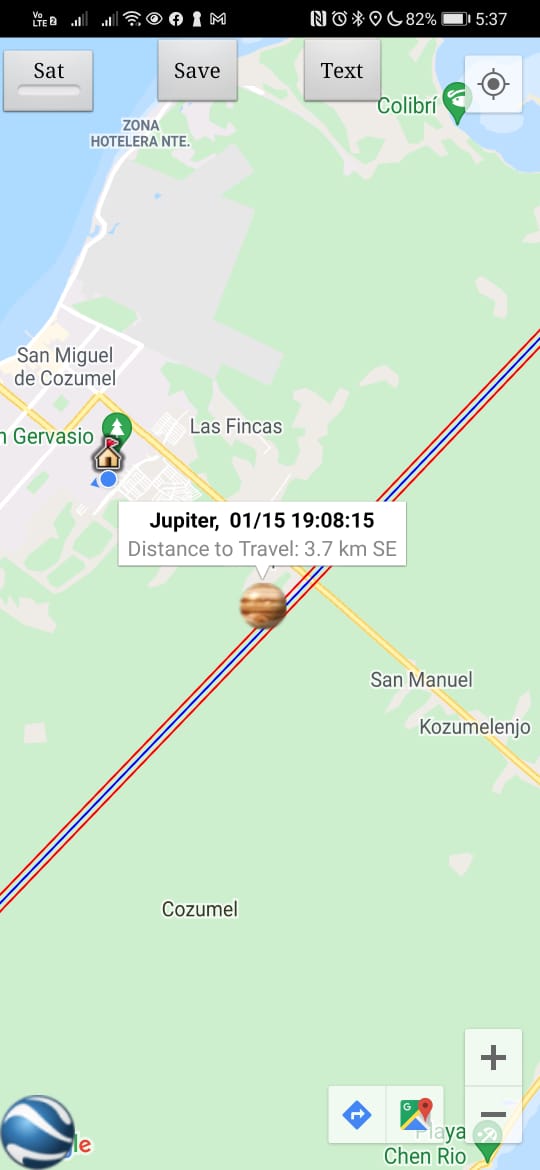
This image is the raw, unedited frame from which I placed the ISS back in its position on Jupiter:
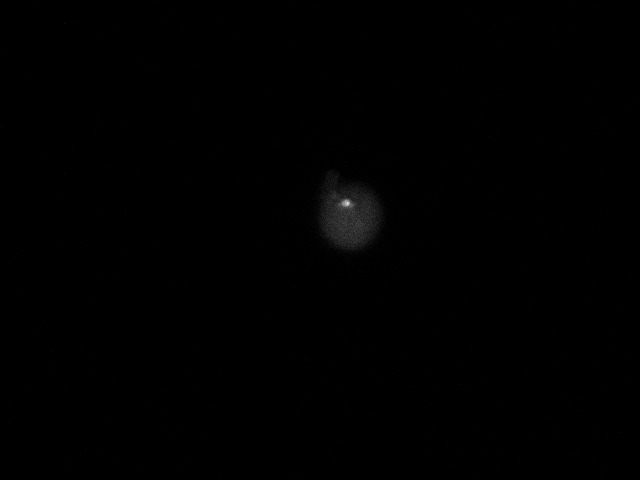
This image has more of the original, unedited, raw frames:
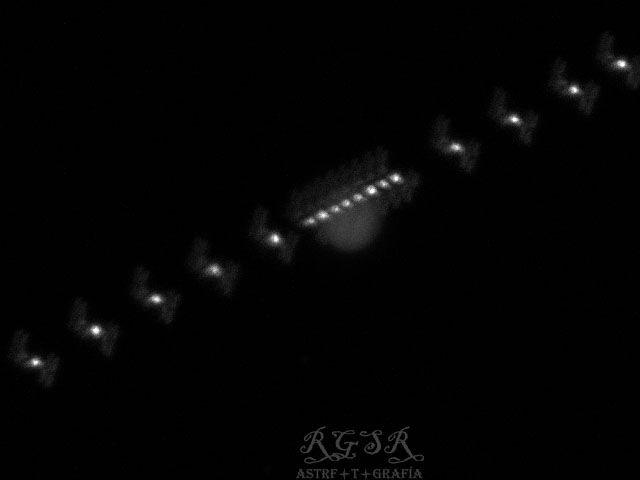
ISS Crossing Jupiter Firmada by
Rene Saade, on Flickr
And this image is the stacked frames of Jupiter (in which we get to see Io) and the ISS, combined:

ISS Transiting Jupiter Stacked Frames
by Rene Saade, on Flickr
The really neat thing is that the stacked frames show the Great Red Spot!! I was also lucky that the ISS transit happened at a time when the Great Red Spot was visible to us on Earth!
The raw frames are 0.35ms, gain 350, ZWO ASI290MM, no filters, on a CEM25P mount. 7:08:15PM (GMT-5), Cozumel, Quintana Roo, Mexico.
On January 15th, 2022, I was talking to a friend in Cozumel who works at the Planetarium. She mentioned that the ISS was going to be near Jupiter that night, and I quickly grabbed my phone and used Ed Morana's ISS Transit Prediction app (You can find it here:
https://play.google.com/store/apps/deta ... l=en&gl=US
And noticed that I was so lucky!! Soooo lucky that the transit was happening in 4 hours, just 10 minutes from my home driving, in a very accessible road!! The weather was not too promising, however. One of the weather apps said 40% cloudy at the time of the transit, others said less than 10%. But I got everything ready: laptop, ZWO camera, telescope, mount, etc and drove there, arriving at around 6:30PM. The transit would happen at exactly 7:08:15 PM (GMT-5), and would last only a fraction of a second! But I was ready! I had read a previous APOD (https://apod.nasa.gov/apod/ap200923.html) had used 0.35ms timing for every frame, and so I used those same settings!!
Here was the location of the transit:

This image is the raw, unedited frame from which I placed the ISS back in its position on Jupiter:

This image has more of the original, unedited, raw frames:

ISS Crossing Jupiter Firmada by
Rene Saade, on Flickr
And this image is the stacked frames of Jupiter (in which we get to see Io) and the ISS, combined:

ISS Transiting Jupiter Stacked Frames
by Rene Saade, on Flickr
The really neat thing is that the stacked frames show the Great Red Spot!! I was also lucky that the ISS transit happened at a time when the Great Red Spot was visible to us on Earth!
The raw frames are 0.35ms, gain 350, ZWO ASI290MM, no filters, on a CEM25P mount. 7:08:15PM (GMT-5), Cozumel, Quintana Roo, Mexico.
Re: Submissions: 2022 January
 A Hole in the Moon by Tom Glenn, on Flickr
A Hole in the Moon by Tom Glenn, on FlickrThis image shows the large impact crater Copernicus along the sunset terminator, with the eastern rim terraces still in sunlight but the crater floor completely shrouded in darkness. The prominent crater Kepler is on the left of the image, and extensive rays can be observed emanating from Kepler, Copernicus and Aristarchus (which is out of frame at upper left). The Hortensius domes region, formed by volcanic activity, is prominent near the center of the image. The image was captured August 24, 2019, at 06:07 local time (PDT) from San Diego, CA.
-
nicola montecchiari
- Ensign
- Posts: 64
- Joined: Tue Sep 14, 2010 3:14 pm
- Location: Milano, Italy
- Contact:
Re: Submissions: 2022 January
(7482) 1994 PC1
Copyright: Nicola Montecchiari
Copyright: Nicola Montecchiari
-
Carballada
- Ensign
- Posts: 22
- Joined: Sat Mar 16, 2019 10:19 am
Re: Submissions: 2022 January
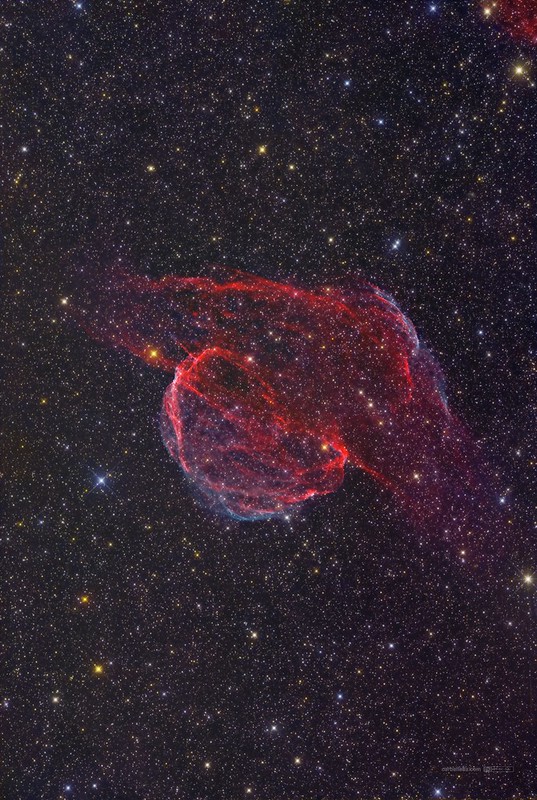
Sh2-224 in natural colors by Jose Carballada, on Flickr
Description of this object from waid-observatory.com :
Sh2-224 is a very faint supernova remnant located approximately 14,700 lightyears distant in the constellation Auriga. This unusual celestial object is also designated VRO 42.05.01 and has been the object of considerable research using both ground based and space based telescopes including the ROSAT and the Dominion Radio Astronomy Observatory. The nebula created by the supernova explosion is composed of two visual parts. It is postulated the supernova explosion created a bubble like structure. (Visible in the 'botton right' of the image.) As the shockwave from the explosion progressed into a very low density region of the interstellar medium, a "wing" component was expelled. (Visible in the 'top right' of the image.)
-
wrightdobbs
- Ensign
- Posts: 29
- Joined: Wed Jan 19, 2022 10:42 pm
Re: Submissions: 2022 January
Starlink Satellite launch from Florida on the evening of January 18, 2022 as they fly below the Orion Constellation.
Composite image.
Foreground and trail are 5 84 second images stitched together with a 20mm lens and Sony a7ii.
Background is two image panorama with a 14mm lens to get the Orion Constellation in frame.
https://live.staticflickr.com/65535/518 ... d206_k.jpg
https://twitter.com/WrightDobbs
https://www.facebook.com/wrightdobbsphotography
https://instagram.com/wrightdobbs
Composite image.
Foreground and trail are 5 84 second images stitched together with a 20mm lens and Sony a7ii.
Background is two image panorama with a 14mm lens to get the Orion Constellation in frame.
https://live.staticflickr.com/65535/518 ... d206_k.jpg
https://twitter.com/WrightDobbs
https://www.facebook.com/wrightdobbsphotography
https://instagram.com/wrightdobbs
Last edited by bystander on Wed Jan 19, 2022 11:53 pm, edited 1 time in total.
Reason: Please, no hot links to images > 500 kb. Substituted smaller image.
Reason: Please, no hot links to images > 500 kb. Substituted smaller image.
Re: Submissions: 2022 January
.
It doesn't have to be in colour to be true....
Fascinating SH2-284
It doesn't have to be in colour to be true....
Fascinating SH2-284
-
isasastroatelier
- Asternaut
- Posts: 2
- Joined: Thu Jan 20, 2022 9:28 am
Re: Submissions: 2022 January
Rosette Nebula
URL website: https://isasastroatelier.ch Location: backyard, Switzerland
Date & time: 14 January 2022, 00:48 – 01:30 a.m.
3 x 600s in H-alpha
Filter: Astrodon Ha 5nm 31
Telescope: Takahashi FSQ-85EDX
Camera: QSI683wsg8 (monochrome)
URL website: https://isasastroatelier.ch Location: backyard, Switzerland
Date & time: 14 January 2022, 00:48 – 01:30 a.m.
3 x 600s in H-alpha
Filter: Astrodon Ha 5nm 31
Telescope: Takahashi FSQ-85EDX
Camera: QSI683wsg8 (monochrome)
-
mikiclinic
- Ensign
- Posts: 46
- Joined: Tue Oct 18, 2011 3:36 pm
Re: Submissions: 2022 January
The change of C/2021 A1 (Leonard) DEC.31.2021 to Jan 4. 2022
This Image was taken with ASA inch f3.6 &FLI ML16200 CCD /2pannel Mosaic image/ SSO remote observatory from Japan
http://miki-hosp.or.jp/BIND/
Copyright: Nobuhiko Miki
This Image was taken with ASA inch f3.6 &FLI ML16200 CCD /2pannel Mosaic image/ SSO remote observatory from Japan
http://miki-hosp.or.jp/BIND/
Copyright: Nobuhiko Miki
Re: Submissions: 2022 January
A fiery bubble and Planetary Nebula
A wide view of the Bubble Nebula and a Planetary nebula (KjPn8) in the constellation Cassiopeia. The Bubble Nebula (NGC 7635) is a HII, emission nebula with the bubble created by the large and hot central star (BD+60˚ 2522) which in the top image is located in the lower part of the bubble. Towers of HII emission can be seen all around the bubble pointing towards the central star. The planetary nebula KjPN8 (PN G 112.5-00.1) is an interesting and unusual planetary nebula. It's located in the upper right of the image. It has a bipolar lobe of about 14 arcmin in size. The central star and core of the planetary nebula is a very small 3-4 arc sec. It's very red and seems to have a ring of HII emission around it. (See the KjPN8 crop above). Click on this image to see the full resolution view and the small core of the planetary nebula. There are several theories about how this planetary nebula formed. New research using ground based and the Hubble Space Telescope points to two separate events. Two bipolar stars essentially creating two planetary nebula. Its one of the largest bipolar lobes known and may be one of the only objects of this type discovered. KjPn8 was discovered in 1971 by M.A. Kazaryn and E.h. Pavsamyan. I collected 19hrs of Ha and OIII data on this object. However it has very little OIII and mainly emits in the HII spectrum.
https://www.starscapeimaging.com/Bubble ... KjPn8.html
Copyright: Jonathan Talbot
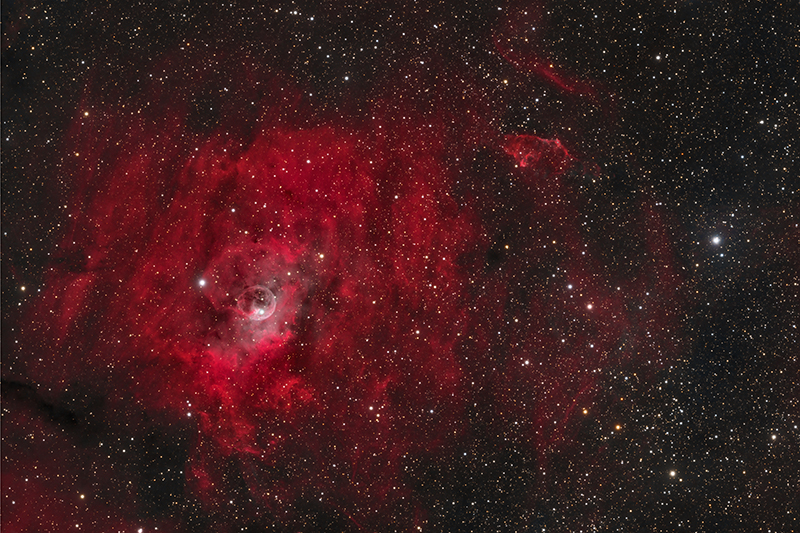
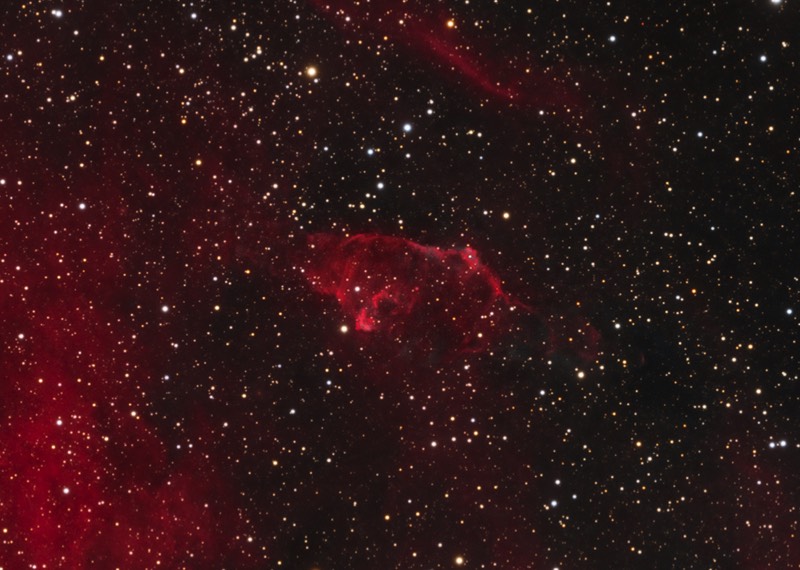
A wide view of the Bubble Nebula and a Planetary nebula (KjPn8) in the constellation Cassiopeia. The Bubble Nebula (NGC 7635) is a HII, emission nebula with the bubble created by the large and hot central star (BD+60˚ 2522) which in the top image is located in the lower part of the bubble. Towers of HII emission can be seen all around the bubble pointing towards the central star. The planetary nebula KjPN8 (PN G 112.5-00.1) is an interesting and unusual planetary nebula. It's located in the upper right of the image. It has a bipolar lobe of about 14 arcmin in size. The central star and core of the planetary nebula is a very small 3-4 arc sec. It's very red and seems to have a ring of HII emission around it. (See the KjPN8 crop above). Click on this image to see the full resolution view and the small core of the planetary nebula. There are several theories about how this planetary nebula formed. New research using ground based and the Hubble Space Telescope points to two separate events. Two bipolar stars essentially creating two planetary nebula. Its one of the largest bipolar lobes known and may be one of the only objects of this type discovered. KjPn8 was discovered in 1971 by M.A. Kazaryn and E.h. Pavsamyan. I collected 19hrs of Ha and OIII data on this object. However it has very little OIII and mainly emits in the HII spectrum.
https://www.starscapeimaging.com/Bubble ... KjPn8.html
Copyright: Jonathan Talbot


Re: Submissions: 2022 January
HI everyone,
Here is my submit for APOD
 nothern lights APOD by Andrea VE, sur Flickr
nothern lights APOD by Andrea VE, sur Flickr
« It has been a long time since we have seen such a beautiful and spectacular solar flare. The material ejected with fury by our Star is now heading towards the Earth and its magnetic field, which it should tickle tomorrow. This is good news for aurora enthusiasts, and of course, photographers who hunt them. Because the shock of the CME (Coronal Mass Ejection) on the magnetosphere, followed by the interaction of solar particles with those of the upper atmosphere, should be visible in sumptuous dances of auroras from this Saturday, October 30, after the plasma has covered the 150 million kilometers that separate us »
This image was taken on 1st November 9.00pm, near Akureyri in Iceland. We were so exiting to see such a spectacle that we run out with a camera and forget to switched off the lights and close the door, those lights that give this image a specific atmosphere.
Thanks Earth, we won’t forget this moment.
Instagram : @andreave71
flickr : https://flic.kr/p/2mYb2Tw
Here is my submit for APOD
 nothern lights APOD by Andrea VE, sur Flickr
nothern lights APOD by Andrea VE, sur Flickr« It has been a long time since we have seen such a beautiful and spectacular solar flare. The material ejected with fury by our Star is now heading towards the Earth and its magnetic field, which it should tickle tomorrow. This is good news for aurora enthusiasts, and of course, photographers who hunt them. Because the shock of the CME (Coronal Mass Ejection) on the magnetosphere, followed by the interaction of solar particles with those of the upper atmosphere, should be visible in sumptuous dances of auroras from this Saturday, October 30, after the plasma has covered the 150 million kilometers that separate us »
This image was taken on 1st November 9.00pm, near Akureyri in Iceland. We were so exiting to see such a spectacle that we run out with a camera and forget to switched off the lights and close the door, those lights that give this image a specific atmosphere.
Thanks Earth, we won’t forget this moment.
Instagram : @andreave71
flickr : https://flic.kr/p/2mYb2Tw
-
barretosmed
- Science Officer
- Posts: 482
- Joined: Thu Oct 12, 2017 6:04 pm
Re: Submissions: 2022 January
Messier 75 (also known as NGC 6864)
It is a globular cluster located in the constellation Sagittarius, 67,500 light-years from Earth.
BEST DETAILS:
https://www.astrobin.com/full/jwrqtx/0/
EQUIPMENT:
ZWO ASI 6200MC COLED
Esprit 150mm
Mount CEM60
86 x 100'' exposure
08/03/2021
Location: Jales - SP - Brazil
Author: Fernando Oliveira de Menezes
(Organizing author of the book Amateur Astrophotography in Brazil)
https://clubedeautores.com.br/livro/ast ... -no-brasil
It is a globular cluster located in the constellation Sagittarius, 67,500 light-years from Earth.
BEST DETAILS:
https://www.astrobin.com/full/jwrqtx/0/
EQUIPMENT:
ZWO ASI 6200MC COLED
Esprit 150mm
Mount CEM60
86 x 100'' exposure
08/03/2021
Location: Jales - SP - Brazil
Author: Fernando Oliveira de Menezes
(Organizing author of the book Amateur Astrophotography in Brazil)
https://clubedeautores.com.br/livro/ast ... -no-brasil
Giant Space Eyebrow
The helix Nebula, NGC7293
Taken November 9th, 2021 from my backyard.
22 shots at 600 seconds each from my backyard with a ZWO ASI2600MC camera, William Optics GT81 telescope, and Losmandy GM811G equatorial mount.
Taken November 9th, 2021 from my backyard.
22 shots at 600 seconds each from my backyard with a ZWO ASI2600MC camera, William Optics GT81 telescope, and Losmandy GM811G equatorial mount.
-
tommasostella
- Ensign
- Posts: 60
- Joined: Mon Nov 11, 2019 4:34 pm
Re: Submissions: 2022 January
The Baby Eagle nebula
https://www.facebook.com/tommaso.m.stella
Copyright: Tommaso Massimo Stella
From: Taranto (ITALY)
Lights: 26x900s, total exposure: 6,5 h
Telescope: Takahashi FS-60CB + Reducer 0,72x
Camera: QHY 168C
Filters: Optolong Astronomy Filter L-CCD
Mount: Skywatcher AZ-EQ6 GT
Processing: DeepSkyStacker, PixInsight, Photoshop CC
https://www.facebook.com/tommaso.m.stella
Copyright: Tommaso Massimo Stella
From: Taranto (ITALY)
Lights: 26x900s, total exposure: 6,5 h
Telescope: Takahashi FS-60CB + Reducer 0,72x
Camera: QHY 168C
Filters: Optolong Astronomy Filter L-CCD
Mount: Skywatcher AZ-EQ6 GT
Processing: DeepSkyStacker, PixInsight, Photoshop CC
Re: Submissions: 2022 January
The Southern Pinwheel Galaxy M83
Copyright: Bogdan Borz
Telecope: Planewave CDK 24"
Camera: FLI Proline 9000
Total exposure: 10h50'
Dates : Multiple nights Feb - Aug 2021
Location: El Sauce Observatory, Rio Hurtado Valley, Coquimbo, Chile
L 16 x 600s
R 6 x 300s 14 x 600s
G 6 x 300s 13 x 600s
B 6 x 300s 13 x 600s
Telescope Live calibrated dataset
Copyright: Bogdan Borz
Telecope: Planewave CDK 24"
Camera: FLI Proline 9000
Total exposure: 10h50'
Dates : Multiple nights Feb - Aug 2021
Location: El Sauce Observatory, Rio Hurtado Valley, Coquimbo, Chile
L 16 x 600s
R 6 x 300s 14 x 600s
G 6 x 300s 13 x 600s
B 6 x 300s 13 x 600s
Telescope Live calibrated dataset
-
dvd007
- Ensign
- Posts: 37
- Joined: Wed Jul 08, 2015 7:54 am
- Location: Saint Paul Lès Dax, France
- Contact:
Re: Submissions: 2022 January
Telescope 200/1000 PERL
Rapport F/D 5
Mount AZEQ6GT PRO
Camera ZWO 1600MM PRO
Exposure 6h
Location Saint Paul Lès Dax, France
L 42x300s
R 10x300s
G 10x300s
B 10x300s
SGP, Pixinsight, Photoshop
 M78 by David Duarte, sur Flickr
M78 by David Duarte, sur Flickr
Rapport F/D 5
Mount AZEQ6GT PRO
Camera ZWO 1600MM PRO
Exposure 6h
Location Saint Paul Lès Dax, France
L 42x300s
R 10x300s
G 10x300s
B 10x300s
SGP, Pixinsight, Photoshop
 M78 by David Duarte, sur Flickr
M78 by David Duarte, sur Flickr-
astronut2007
- Ensign
- Posts: 41
- Joined: Thu Feb 02, 2012 1:07 pm
Re: Submissions: 2022 January
WOLF MOON & THE BELT OF VENUS
Copyright: Alan C Tough
The Wolf Moon of January 2022, seen here rising through the Belt of Venus. Photographed in Elgin, Moray, Scotland on January 17.
Highest resolution image here:
https://www.flickr.com/photos/7776810@N07/51838642026/
Copyright: Alan C Tough
The Wolf Moon of January 2022, seen here rising through the Belt of Venus. Photographed in Elgin, Moray, Scotland on January 17.
Highest resolution image here:
https://www.flickr.com/photos/7776810@N07/51838642026/
-
Yovin Yahathugoda
- Ensign
- Posts: 21
- Joined: Tue Feb 09, 2021 2:56 pm
Re: Submissions: 2022 January
M78 2-panel mosaic
https://www.astrobin.com/users/YovinRY/
Copyright: Yovin Yahathugoda
This image was taken using Telescope Live CHI-1 telescope in El Sauce Observatory, Chile.
Full quality version here: https://cdn.astrobin.com/images/86236/2 ... 78a281.jpg
Telescope - Planewave CDK24
Camera - FLI ProLine PL9000
Filters - Astrodon E-Series RGB
Software - Photoshop 2020 & PixInsight
Location - El Sauce Observatory, Chile
Lum - Synthetic luminance
Red - 36x600s
Green - 36x600s
Blue - 36x600s
Total Exposure time - 18 hours
Full acquisition details at https://www.astrobin.com/7bncfi/0/
https://www.astrobin.com/users/YovinRY/
Copyright: Yovin Yahathugoda
This image was taken using Telescope Live CHI-1 telescope in El Sauce Observatory, Chile.
Full quality version here: https://cdn.astrobin.com/images/86236/2 ... 78a281.jpg
Telescope - Planewave CDK24
Camera - FLI ProLine PL9000
Filters - Astrodon E-Series RGB
Software - Photoshop 2020 & PixInsight
Location - El Sauce Observatory, Chile
Lum - Synthetic luminance
Red - 36x600s
Green - 36x600s
Blue - 36x600s
Total Exposure time - 18 hours
Full acquisition details at https://www.astrobin.com/7bncfi/0/
-
LeftyAstro
- Asternaut
- Posts: 2
- Joined: Wed Jan 12, 2022 2:41 am
Re: Submissions: 2022 January
 LDN 1622, Barnard's Loop and M78 by Markice Stephenson, on Flickr
LDN 1622, Barnard's Loop and M78 by Markice Stephenson, on Flickr~20 nights, 30 hours in HaRGB from Los Angeles
using:
Celestron RASA 8, ZWO 294MM, and Baader's Ha (ultra narrowband) + RGB filters
Thank you,
Markice S
https://instagram.com/leftyastro
- the_astronomy_enthusiast
- Ensign
- Posts: 98
- Joined: Fri Apr 16, 2021 10:16 pm
- Contact:
Re: Submissions: 2022 January

A cluster of rampant star formation and glowing gas: The Great Nebula in Orion by William Ostling, on Flickr
Full write up here: https://theastroenthusiast.com/a-luminous-m42/
The first image of my new mount! The GEM28 has turned out to be an incredibly accurate mount, giving me sharp stars at 600mm with 4 minute exposures!
The Great Orion Nebula, an immense, nearby starbirth region, is probably the most famous of all astronomical nebulas. Here, glowing gas surrounds hot young stars at the edge of an immense interstellar molecular cloud only 1500 light-years away. The bright core illuminates the surrounding the star cluster, highlighting the streams of dark dust on top.
Website: https://theastroenthusiast.com/
Instagram: https://www.instagram.com/the_astronomy_enthusiast/

